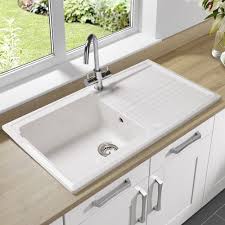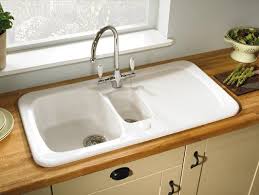The pros and cons of a ceramic kitchen sink
If you’ve fallen in love with a ceramic butler’s sink and are determined to have it in your kitchen, what are the pros and cons to look out for?
Once the domain of a farmhouse or back kitchen and used only by servants, ceramic butler’s sinks are now one of the most sought-after items to form a statement piece in contemporary kitchens.
Rather than let your heart rule your head however, there are factors to consider before switching from stainless steel to these stately articles.
Do they last?
If you’re after added durability, choose a butler’s sink made from the very solid fireclay, a reinforced ceramic clay that is stronger and more durable than porcelain or standard ceramic.
Fireclay is very heavy and its construction from ground pre-fired clay mixed with wet clay and water means it is heat-, impact-, dirt- and stain-resistant and designed to be easy care.
Also chemical resistant, due to the heavy duty glazed surface, which also makes them resistant to chips and scratches and renders the surface hypoallergenic. This coating is compromised however if a chip or scratch does occur.
Breakages
Some butler’s sinks are made from porcelain, which is not as hard wearing as fireclay and more prone to damage and stains, however less expensive to buy.
Working in a kitchen with a ceramic sink takes some adjustment – you’re no longer able to simply throw things into the sink and let things pile up, but need to be more careful than with a stainless steel sink to avoid chips, breakages and stains.
Filling
As they’re modelled on the original farmhouse style, filled only once a day from a remote source rather than a tap overhead, butler’s sinks are generally much wider and deeper than standard sinks, so take longer to fill.

How to Choose the Best Material for Your Kitchen Sink
Choosing the right kitchen sink is absolutely vital, after all, it’s not something that you replace every year like you might a towel or the pillows on your bed. If you get the wrong sink, it can be a costly and time-consuming mistake to put right. But with such a wide variety of kitchen sink materials out there, and an even wider range of prices, how do you know which one is right for your kitchen? In this guide we’ll be looking at the different types of kitchen sinks and discussing their pros and cons, as well as recommending a few of our favourites.
Stainless Steel Sinks
Stainless steel kitchen sinks are still the most popular sinks in the UK, and with a huge variety of sizes, shapes and even finishes available, there is more often than not a stainless steel sink to suit everyone’s needs. Stainless steel sinks are very low maintenance; they are corrosion and rust resistant, and as long as they are cared for properly and wiped down after every use, they should not stain.
One drawback of budget stainless steel sinks is that they are usually made from thinner stainless steel. This not only makes them more prone to dents and scratches, but it also makes them noisier as well. The thicker the stainless steel, the quieter the sink, but also the more expensive. Some of the more expensive sinks also have special sound absorbing pads under the sink to further reduce the noise. As we’ve discussed, stainless steel is generally the cheapest of the materials, but if you’re looking for a top of the range stainless steel sink, you can expect to pay upwards of £400, compared to around £50-100 for a budget one.
Pros:
- Very durable – corrosion and rust resistant and normally come with lengthy guarantees
- Usually the cheapest of all the materials
- Top mount, flush mount and undermount options available
- Low maintenance
Cons:
- Noisy – the thinner the steel the noisier the sink
- Sinks with thin stainless steel are more likely to scratch
- Can get dented easily if something heavy is dropped in it
- The best stainless sinks can cost more than other materials

Granite Composite Sinks
Granite composite kitchen sinks are perhaps the trendiest sinks around. With a huge variety of styles and finishes available, with colours ranging from a classic black to a light cream, and even pink and green, there really is a finish that will suit every kitchen décor. Granite composite sinks, like stainless steel sinks, can be mounted in numerous ways, whether top mount or undermount.
Granite sinks are in general more expensive than stainless steel sinks, but even so they are available from around the £150 mark. Expect to pay slightly more for delivery as well because they are heavier and more fragile in transit. Whilst they are more expensive than stainless steel sinks, the difference in quality between a cheaper and more expensive granite sink isn’t as much as the difference in quality between cheap and expensive stainless steel sinks.
Pros:
- Extremely durable – most granite sinks are heat, stain and scratch resistant
- Prices are coming down all the time
- Anti-bacterial surface which is also easy to clean
- Lengthy guarantees
- Huge range of colours, sizes and styles available
Cons:
- Very hard surface that can damage things that are dropped on it
- Require careful maintenance
- Heavier than stainless steel so need a more sturdy worktop

Fireclay Ceramic Sinks
Ceramic kitchen sinks are still the traditionalists choice. Go into almost any traditional-style kitchen and you’ll find a ceramic sink, and thanks to their durability, there’s a chance that it’s been there for as long as the kitchen. A well maintained ceramic sink can last a lifetime, and thanks to them being easy to clean as well as heat resistant, it can look just as good as the day you bought it.
We have a ceramic kitchen sink in the Tap Warehouse office, and even if tea bags are left in it overnight, it simply takes a wipe of a damp cloth the next morning to have it sparkling clean again. Even if they’re left in over the weekend, on Monday morning it can still be wiped clean – although it may require a little more elbow grease. Of course, we don’t actually recommend doing this; we suggest that you wipe your sink clean after every use as things like red wine can cause more lasting stains.
Ceramic kitchen sinks are the most expensive option, but you still don’t have to break the bank to buy one. Like granite kitchen sinks, they are available from around the £150 mark, but again like granite, you will pay slightly more for delivery due to their fragile nature when in transit. Ceramic kitchen sinks aren’t suitable for everyone though; because of their weight, you must first make sure that your worktop can handle one. This is important if you are planning on top mounting your sink, and it is even more necessary if you are planning on buying a ceramic undermount sink or a Belfast sink.
Pros:
- Easiest to maintain and keep clean
- Extremely durable – heat and stain resistant
- Effortlessly stylish
- Withstands most household chemicals
Cons:
- A more expensive option
- Can chip (although can be repaired)
- Very heavy and less choice available
Kitchen sink details that make the difference
Little things that make every day more wonderful:
- Advanced Waste Systems – superb quality in every detail, from the stainless steel basket strainer to low-profile waste kits that free up extra cupboard space.
- Deeper stainless steel bowls – giving you extra space without compromising their strength.
- Heat & sound insulation – not only reducing the sound of water running into the bowl but also keeping water warmer for longer.
- Push-button pop up waste – a smart, simple way to empty the bowl. No need to put your hands into a sink full of dirty water.